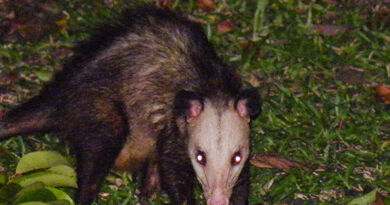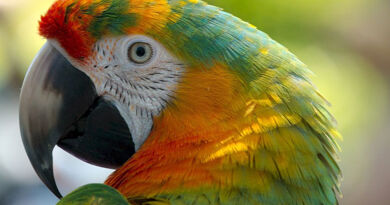Mongoose
Tawny color sometimes grayish, short on legs, bushy tail, fast as lightning, you have certainly seen it crossing our roads at full speed, to then slide always as quickly through, the fields of sugar cane ? It is our Mongoose, the only representative in our islands of one of the richest families of the order of carnivores: the family of Viverridae. Representatives of this family have in common: a modest size, elongated shapes, a thin trunk, a long tail with the hair provided and ending in a point, a small head with a pointed muzzle carrying long mustaches. The legs, very short, are usually provided with five fingers with non-retractable claws in most cases.
Geographical distribution For this it is more correct to speak of the Mongooses because the latter being part of the Herpestinae subfamily include ten genera, about thirty species and one hundred and seventy subspecies distributed in Africa, in the South and in the East of the Mediterranean basin , in India, in South East Asia, up to South China and the big Sunda Islands, and currently in some islands of the Antilles where they were introduced in the middle of the 19th century.
Advocacy for the introduction of the Mongoose to Guadeloupe in 1887 “… I have every reason to think that the chamber of agriculture will take care of the introduction of the Mongooses, with a view to destroying the rats which, in certain districts, devastate our various crops; it would perhaps be wise to first make only Mongooses not susceptible to reproduction, so as not to have to fear the spread of the species. Later, we should not regret having introduced a new pest into the country. “
It is in these terms that in July 1887, Monsieur de Zévallos made a communication to the Chamber of Agriculture of Pointe-à-Pitre in favor of the introduction into Guadeloupe of the Mongoose of India. This position was not unique, because long before, J. Luman had already advocated in 1816 the introduction of this mongoose in Jamaica to fight the rats which devastated the fields of sugar cane. Thus in 1874 Mister Baneroft Espeut, owner of a house in Jamaica “succeeded in bringing directly from India nine male and female subjects, who cost him a pound sterling for transport costs”. Successful essay, unlike those previously tried with Mongooses imported from London; this is how Mr. Espeut was able to distribute it in various houses close to his.
This experience spread to other islands in the West Indies: Cuba, Puerto Rico, Saint Thomas, Saint Croix, Grenada, Barbados. It was in 1888 according to the writings of R. P. Pinchon that the first mongooses were introduced to Guadeloupe, always with the aim of destroying the rats which constituted a veritable plague in the sugar cane plantations; and it was between 1890 and 1891 that a few pairs of mongooses from Guadeloupe, then from Barbados were introduced to Martinique to fight the famous snake The lanceolate Bothrops which haunted the whole island, because already the Mongoose had acquired a serious reputation in this kind of fight, so much so that in certain regions of India it is considered as a domestic animal in the same way as the cat, it is responsible for destroying in the house snakes and rats.
The Mongoose is an animal that is easily tamed It seems that among the Mongooses introduced to Martinique some even left the woods, to come and settle in the houses and this is how we can read in the booklet “The Serpent of Martinique” “… Only about forty years ago, most Creole families living in the countryside had their domestic mongoose. When a Mongoose adopts a house, it should not be locked up. If the children don’t mistreat her, if the dogs leave her alone, she doesn’t go away; for there is no more curious animal in the world and the number of objects that a Mongoose can discover in a house is incalculable. She is more trapped in her curiosity – a tireless, sickly, ancestral curiosity – than if she was put in a cage. As a sign of welcome, it is enough to give her a few small pieces of raw meat, a little egg yolk and twenty-four hours have not elapsed, that she brushes against the master’s legs, cuddly like a cat. She climbs on her knees, burns her muzzle on her cigarette, tries to enter her pockets, intrigued by the ticking of her watch. She goes down, it is to run, busy, from one room to another. She has to be aware of everything, she climbs on tables, on seats, on beds, stuffs her pink nose in the blankets, perpetually agitated, the ear on the watch, wiggling at the slightest noise, at the lightest rustling. Sometimes we stay a whole day without seeing it. She is in the garden. She inspects the hedges, the “edges”, searches the squares of “okra”, Caribbean cabbage. In the evening, we see her come back at dinner time, the hair soaked by the last shower, the lips slightly tinged with red. During her absence, she may have killed two or three Bothrops. (Henry de Lalung).
An introduction that failed Easily tame indeed, guardian of houses against mice, rats and snakes, the Mongoose did not stop there. Thanks, on the one hand, to its large reproductive capacity, 3 to 4 litters per year, from 4 to 5 young each, on the other hand thanks to a very pronounced taste for poultry, birds and other animals, the mongoose, a formidable carnivore, quickly became a factor in the islands where it had been introduced. It is certainly true that with his arrival we could note a significant decrease in rats and snakes, but also in many other species, birds, reptiles, small mammals existing in our fauna. The rats sensing the danger have changed their way of life, from terrestrial, they have become arboreal so out of reach of the Mongoose. Snakes have defined other territories making them less frequent meetings with our mongoose which for food was interested in chicken coops, bird nests, where it wreaked havoc, eating widowers and nestlings. The Iguanas and the “Big Frogs” that existed at that time in Martinique were not immune, nor were small mammals such as the Agouti. The mongoose’s stomach had then become a real cemetery for our fauna. This is a real example of the creation of an imbalance by the introduction of a foreign species.
Fauna in full expansion As the situation worsened, the authorities took steps to encourage the destruction of the Mongoose. Thus a bonus of 5 F was distributed in the gendarmerie brigades per head of mongoose killed. All that did not do much because the Mongoose remains all the same in Martinique an animal very frequent which even the day approaches the dwellings seeking in the trash cans or in the piles of refuse a meager pittance. The Mongoose nowadays does not trigger the same hatred among our peasants as before, it lives almost in total indifference. Hunting Mongoose in Martinique is no longer considered by farmers as an obligation.




